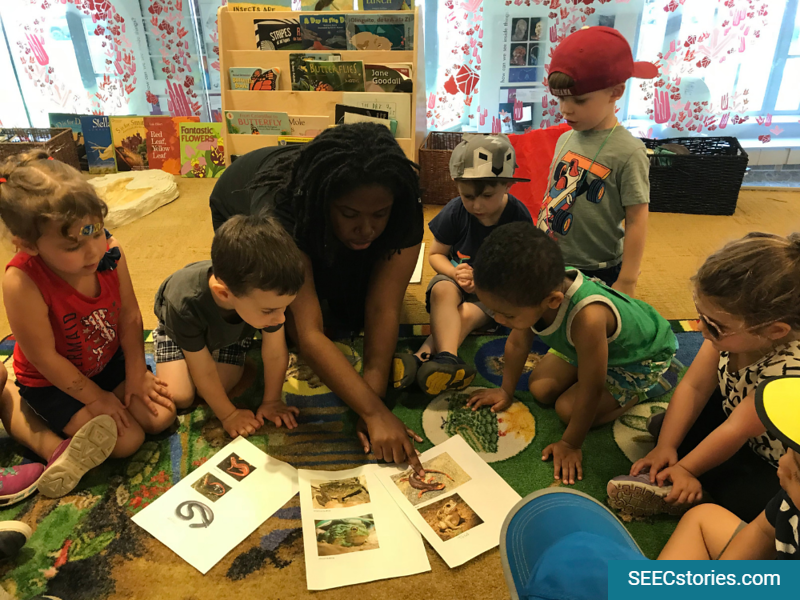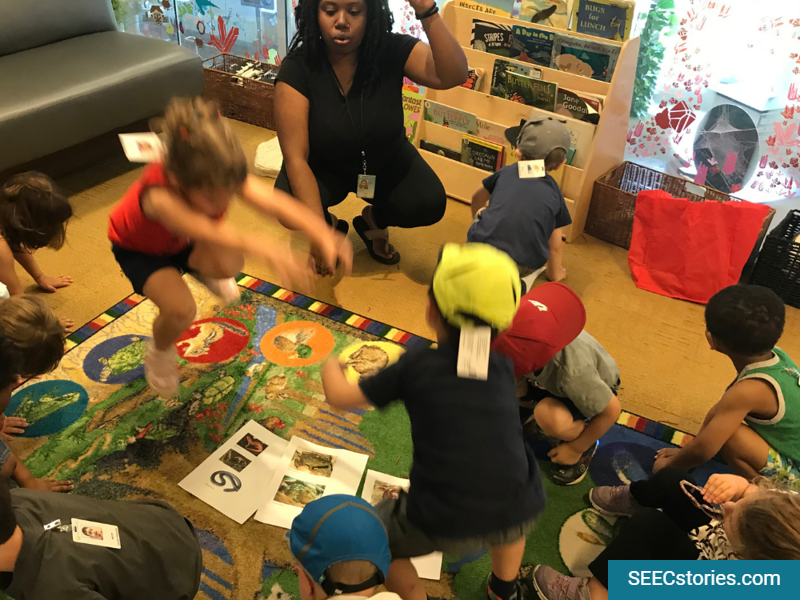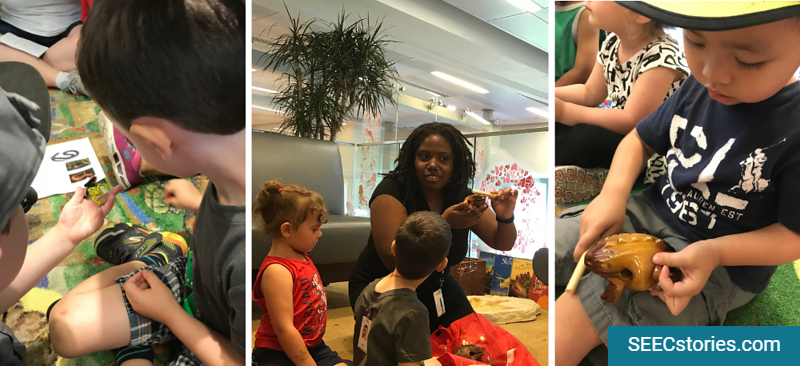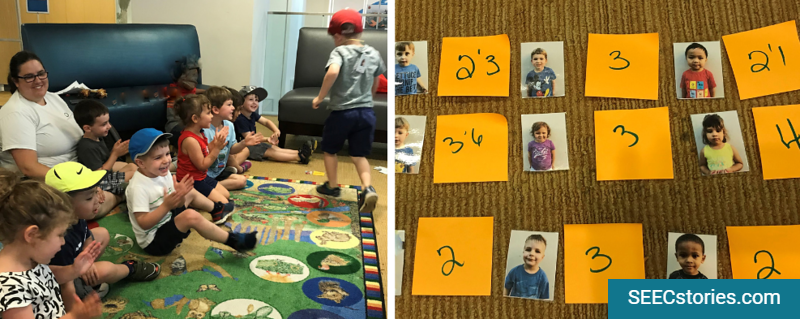This post was written by Maureen Leary, Director of Toddler and Kindergarten Programs
Value of Virtual
When the Smithsonian closure due to Coronavirus health concerns was announced in mid-March, none of us had a clear sense of how long it would last. Once it became obvious that it was going to be more than a few weeks, SEEC faculty immediately transitioned to conducting distance learning through online platforms. Teaching young children this way is neither ideal nor intuitive, but we knew we needed to quickly develop these skills to better support our families. At SEEC we believe it’s important for us to offer virtual interactions for a number of reasons. It provides personal connections during a time when we can’t experience them directly; it offers an anchor point for themes and topics that families can explore in their own way and on their own time; it inserts some amount of structure into the days and weeks that have been completely upended; it allows children to retain a level of comfort and familiarity with peers and educators during what has turned into an extended closure with no definitive end.
The Challenges of Virtual
Many families are craving the connections and routines that suddenly disappeared from our lives, and appreciate the opportunity to see each other virtually. That said, we also know that consistently participating in these interactions can sometimes be a challenge. Maybe your child is tired, hungry, grumpy, or just uninterested. It could be that you have a work conflict and you can’t prioritize your child’s meeting over your own. Perhaps you’re feeling overstretched and just don’t want to add one more thing to your day. Skipping your child’s scheduled activity might cause feelings of guilt and worry, and cause you to wonder if it’s ok to be missing these online interactions. At SEEC our answer is always an emphatic yes. We encourage families to follow their children’s leads on what helps the day go smoothly for them. It might be that they’d rather go outside during a virtual circle time, or that they just have no interest in it at all. Maybe they refuse to talk or get frustrated with how the conversation goes. All of this is developmentally appropriate and totally ok. Enrichment can be found in so many ways, in moments small and large, and doesn’t always have to be carefully orchestrated. What’s really important right now is that all of us, children and adults, feel cared for and supported.
Tips for Virtual
If you do choose to participate in an online “circle” here are some helpful hints compiled from conversations we have been having with our SEEC community.
- Some children are camera-shy. Don’t insist that they talk or even appear on the screen. Giving them repeated exposure to the format and letting them develop comfort with it at their own pace is likely to increase their participation. And if it doesn’t, that’s ok, too!
- If your child is reluctant to talk but does want to be included, suggest they give a virtual high-five or a thumbs up as a way to connect with others.
- Check with your child’s teachers about scheduling some one-on-one screen time. Even just 10 minutes of individual attention this way can pay big dividends.
- Some families have found it’s easiest to pair distance learning with snack time, so the child is staying in one place and not becoming distracted by other surroundings.
- Alternatively, if the weather’s nice and it’s hard to be inside, try bringing your screen outside and participating that way. We’ve seen toddlers actively engage in circle time while also riding a tricycle down the street!
Screen Time
One final, related note: a recurring concern with the current environment is that young children are getting more screen time than is recommended. This is an issue we are always thinking about, and while we agree it’s best to limit screen time for young children, we do believe that distance learning offers important benefits, especially as we practice social distancing. At SEEC, we generally advocate for the limited use of screens when they are a single element of a larger, interactive experience. Of course, there may be families who opt out entirely of distance learning for the screen time concern alone, and that is also a decision we respect. We always want families to do what feels right for their own well-being, and it certainly won’t be the same for everyone. We encourage you to trust your instincts, be responsive to the needs of your child, and reach out to your child’s educators if you have any questions or concerns.

















 In keeping with the awards season time of year, SEEC held its annual Staff Appreciation dinner recently in order to recognize the hard work and dedication of our entire team. It was also a great opportunity to kick back, relax, and enjoy some time together.
In keeping with the awards season time of year, SEEC held its annual Staff Appreciation dinner recently in order to recognize the hard work and dedication of our entire team. It was also a great opportunity to kick back, relax, and enjoy some time together.










 Smithsonian and stop by the Sackler Gallery to see the
Smithsonian and stop by the Sackler Gallery to see the 
 In the fall of 2015, the Friends of the National Zoo, National Museum of African American History and Culture, National Air and Space Museum, National Museum of American History, National Museum of Natural History, Smithsonian Associates’ Discovery Theater, and the Smithsonian Early Enrichment Center, together with the DC Promise Neighborhood Initiative (DCPNI) were awarded a two-year grant through Grow Up Great, PNC’s initiative focused on early childhood education, to launch Word Expeditions. The grant’s objective is to build vocabulary in preschool students from the Kenilworth-Parkside neighborhood in Northeast DC. DCPNI works exclusively with this neighborhood supporting all members of the Kenilworth-Parkside and describes its mission as “improving the quality of their own lives and inspiring positive change in their neighborhood.” The group has a strong foothold with families of young children and so it seemed natural to integrate Word Expeditions into their already existing Take and Play structure. Once a month, Smithsonian representatives visit Neval Thomas Elementary School during which time, families participate in activities that teach about the Institution’s collections, build vocabulary, and support a child’s development. The evening concludes with a meal and families take home a kit from DCPNI outlining fun and simple ways to incorporate learning and vocabulary skills at home.
In the fall of 2015, the Friends of the National Zoo, National Museum of African American History and Culture, National Air and Space Museum, National Museum of American History, National Museum of Natural History, Smithsonian Associates’ Discovery Theater, and the Smithsonian Early Enrichment Center, together with the DC Promise Neighborhood Initiative (DCPNI) were awarded a two-year grant through Grow Up Great, PNC’s initiative focused on early childhood education, to launch Word Expeditions. The grant’s objective is to build vocabulary in preschool students from the Kenilworth-Parkside neighborhood in Northeast DC. DCPNI works exclusively with this neighborhood supporting all members of the Kenilworth-Parkside and describes its mission as “improving the quality of their own lives and inspiring positive change in their neighborhood.” The group has a strong foothold with families of young children and so it seemed natural to integrate Word Expeditions into their already existing Take and Play structure. Once a month, Smithsonian representatives visit Neval Thomas Elementary School during which time, families participate in activities that teach about the Institution’s collections, build vocabulary, and support a child’s development. The evening concludes with a meal and families take home a kit from DCPNI outlining fun and simple ways to incorporate learning and vocabulary skills at home. A few weeks later, families are invited to come to the museum that co-hosted the
A few weeks later, families are invited to come to the museum that co-hosted the
 accompanied by what I like to call, conversation starters. These conversation starters include key vocabulary terms that help families define some big ideas they can use to discuss the object. They also pose open-ended questions and suggest easy ways to engage with the object and use the vocabulary in ways that will help children understand and recall the word’s meaning. For example, The Smithsonian Gardens description asks families to look closely at an elm tree and find its parts. The children will walk away with a concrete understanding of terms like roots, trunk and bark. The National Portrait Gallery’s entry asks families to imagine what they would see, hear and taste if they jumped into the portrait of George Washington Carver and suggest that parents use the term five senses and, of course, portrait.
accompanied by what I like to call, conversation starters. These conversation starters include key vocabulary terms that help families define some big ideas they can use to discuss the object. They also pose open-ended questions and suggest easy ways to engage with the object and use the vocabulary in ways that will help children understand and recall the word’s meaning. For example, The Smithsonian Gardens description asks families to look closely at an elm tree and find its parts. The children will walk away with a concrete understanding of terms like roots, trunk and bark. The National Portrait Gallery’s entry asks families to imagine what they would see, hear and taste if they jumped into the portrait of George Washington Carver and suggest that parents use the term five senses and, of course, portrait. I find that dinner time at the Take and Play program provides the perfect opportunity for me to get to know families on a deeper level as I talk with them about the maps and their museum visits. Recently, I engaged in a conversation with two families who have become “regulars” at the workshops and museum visits. When I asked what museums the families had visited lately, the mothers immediately began to list all of the museum trips they had been on since the program’s inception in the fall and what’s more, they described their visits in detail – recalling the vocabulary that was introduced and the activities in which they participated. It was exciting to see their enthusiasm for the program and it was clear that the map had helped foster and grow their interest in museums.
I find that dinner time at the Take and Play program provides the perfect opportunity for me to get to know families on a deeper level as I talk with them about the maps and their museum visits. Recently, I engaged in a conversation with two families who have become “regulars” at the workshops and museum visits. When I asked what museums the families had visited lately, the mothers immediately began to list all of the museum trips they had been on since the program’s inception in the fall and what’s more, they described their visits in detail – recalling the vocabulary that was introduced and the activities in which they participated. It was exciting to see their enthusiasm for the program and it was clear that the map had helped foster and grow their interest in museums. 